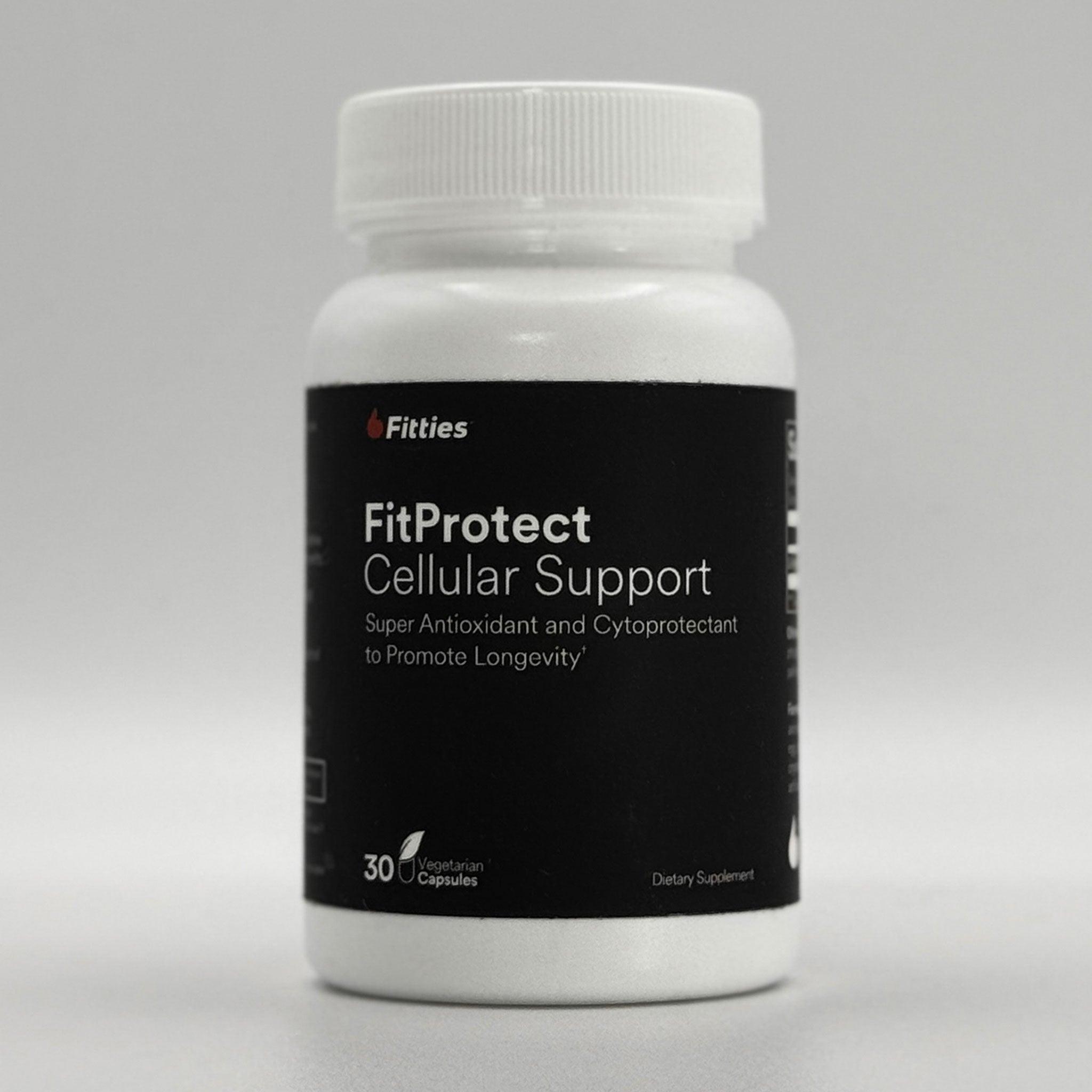
Medical References: FitProtect
Medical-grade fermentation-based L-ergothioneine from Fitties
Medical References: FitProtect
Clinical Applications
- Supports neurologic and cognitive health*
- Provides cellular antioxidant support*
- Supports maintenance of glutathione levels already in a healthy range*
FitProtect presents a highly concentrated variant of the histidine-based compound L-ergothioneine, synthesized using an exclusive fermentation process. Leveraging its potent antioxidant and cytoprotective properties, L-ergothioneine effectively counteracts oxidative stress in various body systems, offering a range of health advantages.*
Discussion
L-ergothioneine (L-ET), a thiol/thione histidine derivative, is produced by select fungi and bacteria.[1] Recent scientific studies have highlighted L-ET's cytoprotective and antioxidant attributes, sparking significant interest in its potential health benefits for humans.[1,2] Since L-ET is not synthesized by humans, it must be obtained via diet.[1,2] The most abundant dietary source of L-ET is mushrooms, although it's present in smaller quantities in various other foods.
Mammalian cells absorb dietary L-ET through a specific membrane transporter protein (OCTN1), which is variably present in most tissues.[3] Consumption patterns of L-ET vary geographically, with average daily intake in the U.S. being around 1.1 mg, compared to up to 4.6 mg in some European nations, like Italy.[1] Aging is associated with reduced L-ET levels. Studies have shown that supplementation is an effective method to boost L-ET levels in the blood. A controlled human study demonstrated that oral intake of L-ET (5 or 25 mg/d) significantly elevated L-ET levels in plasma and blood in a dose-responsive manner, with notable retention.*[4]
Antioxidant and Cellular Protector
L-ET's role as a potent physiological cellular protector is well-established, with its reactive molecule neutralizing capabilities well-documented.[2,3] Its antioxidant effects, both in vitro and in vivo, are significant.[5] L-ET is known to slow down oxidative stress-related telomere shortening, which is relevant to studies on human longevity.[6] It also appears to protect against nuclear and mitochondrial DNA damage, thereby acting as a genomic stabilizer.[7] L-ET also maintains levels of cellular-reduced glutathione and triggers Nrf2/ARE-mediated antioxidant genes, underscoring its unique antioxidant and cytoprotective actions.[3,8] These properties position L-ET as a promising agent for supporting longevity, enhancing exercise performance, and managing various conditions related to oxidative stress.*[3,9]
Neurological System Support
In terms of neurological health, L-ET penetrates the blood-brain barrier and offers neuroprotection.[2,5] As humans age, their L-ET blood levels decline, with more rapid decreases seen in individuals with mild cognitive impairment.[1,2] A study involving 496 participants linked low L-ET levels with increased dementia severity, suggesting its potential as a biomarker for cognitive impairment. Advanced neuroimaging revealed significant associations between low L-ET levels, cortical thinning, and reduced hippocampal volumes.[10] Animal studies also indicate that L-ET may alleviate stress-induced sleep disorders and depressive-like symptoms.[11,12] A 2022 double-blind, randomized clinical trial involving 95 individuals with high anxiety and sleep issues found that a 4-week regimen of 20 mg/d ergothioneine mitigated sleep problems, including wakefulness frequency.*[13]
FitProtect
FitProtect is a highly pure (99%), concentrated L-ET product, developed through a unique fermentation process. This eco-friendly production method, preferable to chemical synthesis or complex extraction from foods, yields a stable thione-based L-isomer in its free amino acid form. Various studies attest to the efficacy of the ergothioneine produced by this method. Cellular studies using healthy human donor cells highlighted FitProtect's high bioavailability, as evidenced by its accumulation in red blood cells without compromising its antioxidant properties.[14] FitProtect has demonstrated robust antioxidant activity, cell viability protection, cytokine modulation, immune support, significant mitochondrial function enhancement, and substantial improvement in cellular energy production under oxidative stress.[14] In studies on irradiated human keratinocytes, 30 μM of FitProtect moderately boosted the expression of genes (e.g., Nrf2 regulated) involved in oxidative and cellular stress responses.[15] Investigations using Caenorhabditis elegans showed notable lifespan increases and gene expression changes related to insulin response, energy metabolism, and longevity pathways (e.g., autophagy).[16] FitProtect also decelerated degeneration in a C. elegans strain expressing amyloid beta in body muscles without impacting its reproduction or development.[17] A 2021 multi-case clinical report indicated that subjects taking 25 mg/d of FitProtect experienced a 13% to 146% increase in total glutathione from baseline to day 30.*[18]
References
- Beelman RB, Kalaras MD, Phillips AT, et al. J Nutr Sci. 2020;9:e52. doi:10.1017/jns.2020.44
- Halliwell B, Cheah IK, Tang RMY. FEBS Lett. 2018;592(20):3357-3366. doi:10.1002/1873-3468.13123
- Borodina I, Kenny LC, McCarthy CM, et al. Nutr Res Rev. 2020;33(2):190-217. doi:10.1017/S0954422419000301
- Cheah IK, Tang RM, Yew TS, et al. Antioxid Redox Signal. 2017;26(5):193-206. doi:10.1089/ars.2016.6778
- Fu TT, Shen L. Front Pharmacol. 2022;13:850813. doi:10.3389/fphar.2022.850813
- Samuel P, Tsapekos M, de Pedro N, et al. J Diet Suppl. 2022;19(2):212-225. doi:10.1080/19390211.2020.1854919
- Paul BD, Snyder SH. Cell Death Differ. 2010;17(7):1134-1140. doi:10.1038/cdd.2009.163
- Hseu YC, Vudhya Gowrisankar Y, Chen XZ, et al. Oxid Med Cell Longev. 2020;2020:2576823. doi:10.1155/2020/2576823
- Fovet T, Guilhot C, Delobel P, et al. Front Physiol. 2022;13:834597. doi:10.3389/fphys.2022.834597
- Wu LY, Cheah IK, Chong JR, et al. Free Radic Biol Med. 2021;177:201-211. doi:10.1016/j.freeradbiomed.2021.10.019
- Matsuda Y, Ozawa N, Shinozaki T, et al. Transl Psychiatry. 2020;10(1):170. doi:10.1038/s41398-020-0855-1
- Nakamichi N, Nakayama K, Ishimoto T, et al. Brain Behav. 2016;6(6):e00477. doi:10.1002/brb3.477
- Katsube M, Watanabe H, Suzuki K, et al. J Funct Foods. 2022;95(105165):1-12. doi:10.1016/j.jff.2022.105165
- Jensen GS. Report 174-001. NIS/NNB UA; 2021. Unpublished.
- Pedretti N. Study report FD210417 version 2. Bioalternatives; 2021. Unpublished.
- Saunders A. Report. InVivo Biosystems; 2021. Unpublished.
- Weinkove D. Magnitude Biosciences; 2021. Unpublished.
- Burdette C. Final Study Report. Burdette Consulting Services; 2021. Unpublished data.